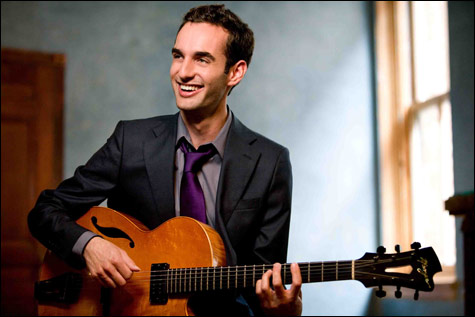
MORE THAN GUITAR The unusual mix of instrumentation and personalities in his band compelled Lage to write unique pieces. |
By the time he was 12, Julian Lage was playing jazz guitar on the Grammy Awards in a short feature for up-and-coming talent. Gary Burton caught Lage's brief solo and was impressed. It wasn't just Lage's technical command. "The time feel and the flow of what he was playing was right in the groove, and very hard to do for 20 seconds," Burton said later. "The spotlight swings to you, and you're on in front of 500 million people, and it's like, 'Okay, play.' That's hard for me to do. And I said to myself, 'Hey, that's the real thing. He can play.' "
A few years later, the kid from Santa Rosa, California, was in Burton's quartet — at 17. During breaks from school, he toured and recorded two CDs with the vibes legend and long-time Berklee educator. It was easy to hear on those two albums what Burton heard: not just fingers, but a kind of freaky wisdom in his feel for dynamics and groove, a maturity that sounded lived-in rather than copped.
All well and good. Those Burton dates — as well as tours and a recording with Lage's Cali compatriot, pianist Taylor Eigsti — would lead you to expect that the youngster would some day make a very nice jazz-guitar record: familiar material played with the freshness of first love, inspired if not earth-shaking.
What Lage delivered earlier this year with Sounding Point (EmArcy) was something else again. Instead of a standard jazz quartet, we get a core group — who will join Lage at Scullers next Thursday — of guitar, alto saxophone (Ben Roseth), cello (Aristides Rivas), bass (Jorge Roeder), and percussion (Tupac Mantilla). And isn't just the classical-chamber-music signifier of cello that marks a difference. There's no trap set on the date — Mantilla plays hand drums. Neither did Lage feel compelled to deploy the entire quintet on every track, mixing and matching his players in duos and trios (as well as offering the requisite guitar solos). Eigsti joins in on a couple of numbers. And three tracks feature Lage on acoustic guitar in a trio with banjo star Béla Fleck and mandolinist Chris Thile of Nickel Creek and the Punch Brothers.
The writing is just as unconventional as the instrumentation. Burton and Lage had played the guitarist's "Clarity" in lilting waltz time, stating the melody in unison from the get-go, in a standard jazz arrangement of alternating solos and comping. On Sounding Point, Lage introduces the melody as a hesitant climbing guitar figure before the band come in for an "In a Silent Way"–type mysterious chord and alto sax picks up the melody over rubato flurries of rhythm (including another track of saxophone). The melody darts in and out of the arrangement in ensemble unison statements or passed in fragments from instrument to instrument — a sweet cello line, a raspy alto. In one solo, the guitar climbs from buzzing vibrato lower strings to a high glycerine-toned climax in an ecstatic outpouring. The appealing nursery-rhyme sweetness of the duo version with Burton has become something else, free time alternating with an African 6/8 feel. The tune's essential sunniness — its "clarity" — now emerges from alluring passages of darkness and ambiguity.